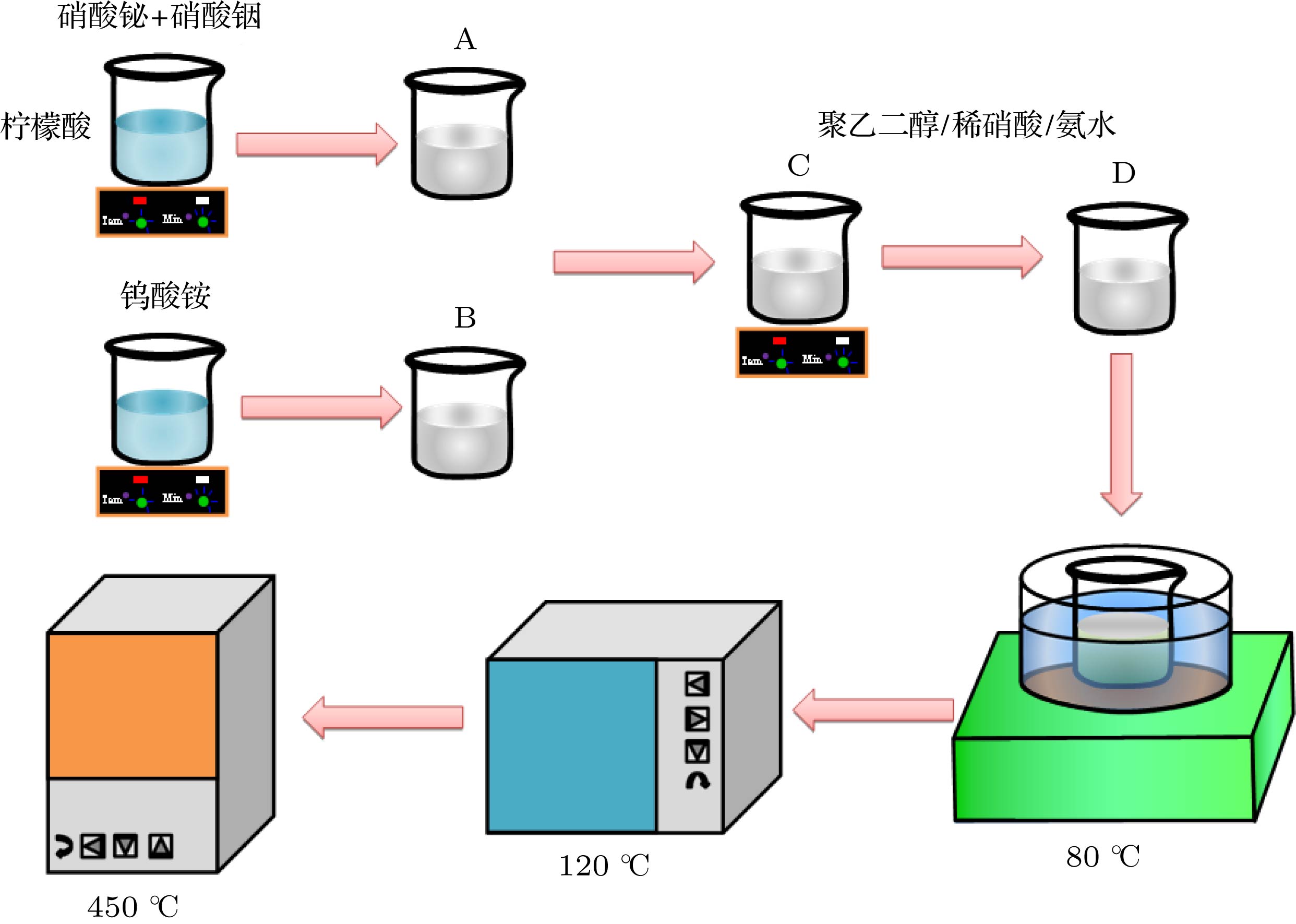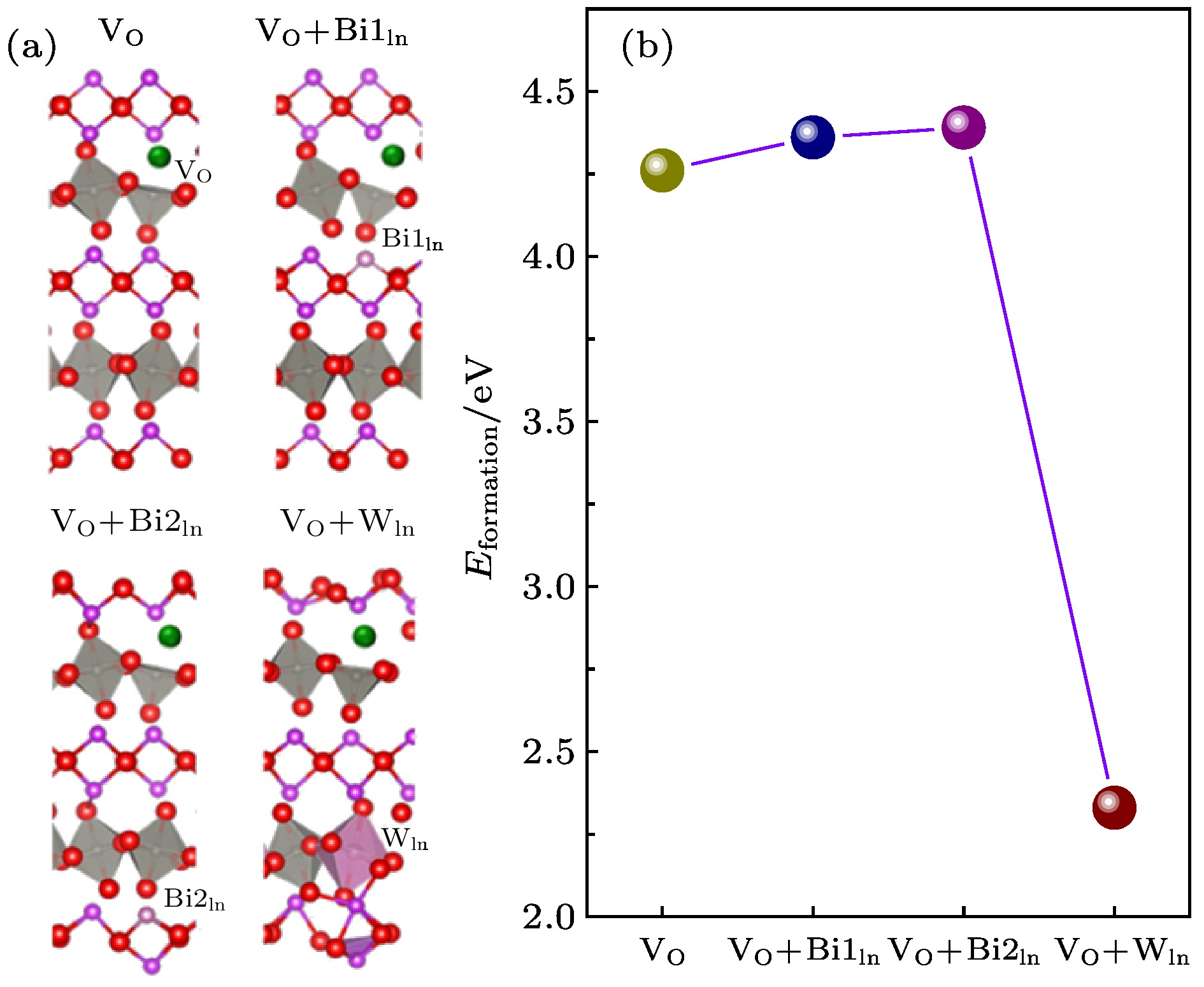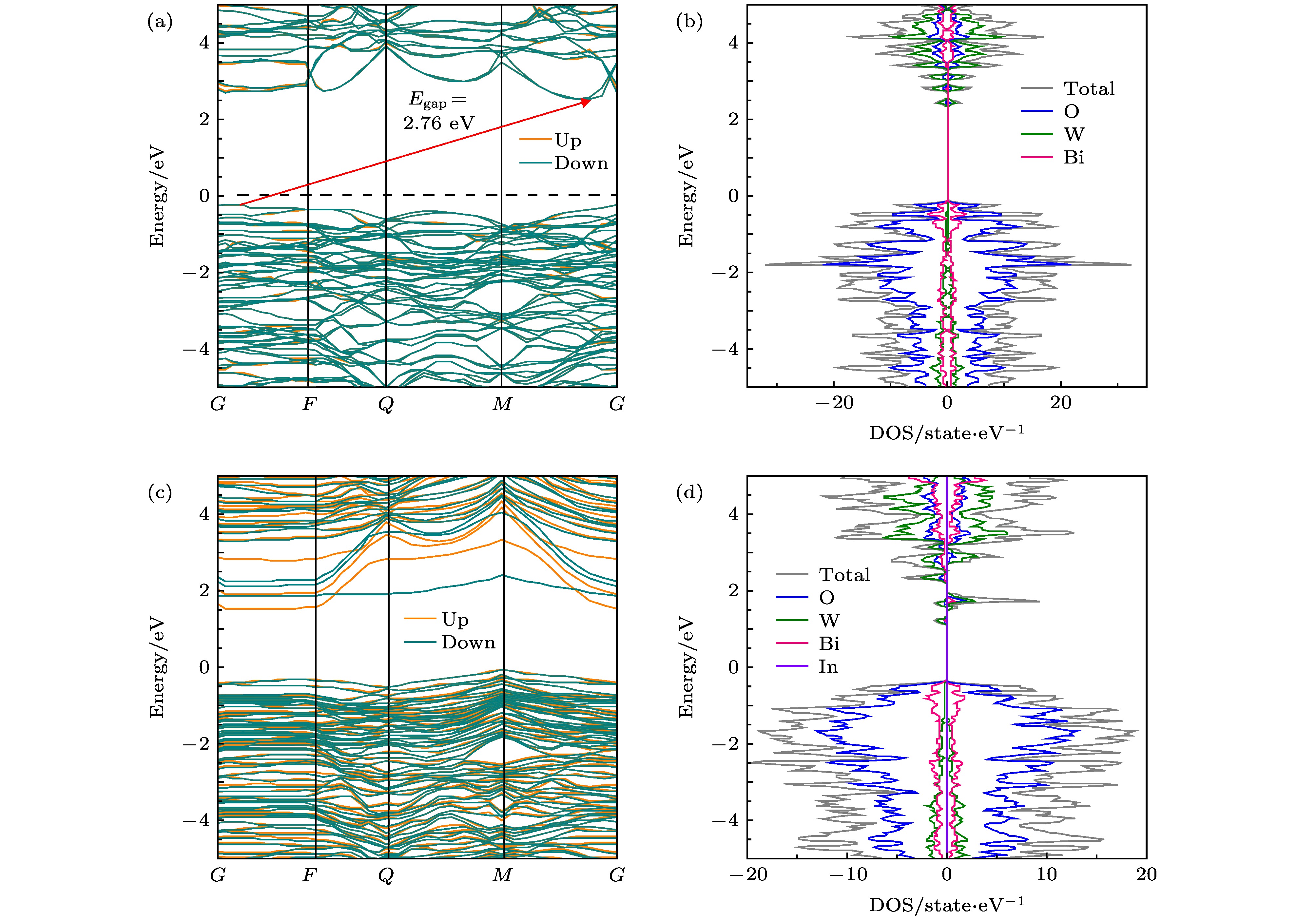-
以硝酸铋、硝酸铟、钨酸铵、柠檬酸、聚乙二醇为原料和表面活性剂, 通过溶胶-凝胶法合成纯的和铟掺杂正交晶系钨酸铋. X射线衍射表征得到所有样品都是纯相且无杂质相. 光催化降解罗丹明B实验发现, 铟掺杂样品降解能力高于纯相, 其最佳掺杂含量为7%摩尔比. 扫描电子显微镜和X射线光电子能谱表征发现, 光催化性能提高主要是由于氧空位数目增多导致, 而形貌发生蓬松改变起到促进作用. 利用第一性原理计算, 单一氧空位模型形成能小于Bi1In + VO和Bi2In + VO共掺杂模型形成能, 而大于WIn + VO形成能. 这个结果表示铟替代钨位促进氧空位产生. 电子结构计算发现, 氧空位在带隙和导带底附近引入新的局域态, 促进光吸收而增强光催化性能. 本文通过理论模拟和实验表征钨酸铋氧空位光催化性能调控归因于铟进入钨位而非铋位.Pure and In-doped orthorhombic Bi2WO6 are synthesized by sol-gel method through using raw materials Bi(NO3)3·5H2O, In(NO3)3·6H2O, (NH4)2WO4 and surfactants citric acid, polyethylene glycol. All samples are in pure phase without impurity phase as indicated by X-ray diffraction characterization. The In-doped sample degradation efficiency for rhodamine B is higher than that for pure phase with the optimal content 7% mole ratio. Because indium impurity adhering to Bi2WO6 nucleus surface may affect the crystallization range, the sample morphology gradually becomes fluffy and regular, which is reveled through scanning electron microscopy analysis. This morphology change plays an important role in electron-hole transport process as well as contact area of carrier and organic molecule. Using X-ray photoelectron spectroscopy (XPS) characterization and Gaussian fitting, it is found that the O 1s XPS peak of pure and In-doped sample each contain three peak sites. The low energy peak around 530 eV originates from W—O and Bi—O bond. The high peak is ascribed to lattice oxygen defect and its intensity is enhanced gradually with the increase of In content. Thus the increase of oxygen vacancies is the main reason for this photocatalytic performance improvement. Comparing with the impurity-free sample, the visible absorption of In-doped Bi2WO6 is enhanced and the corresponding band gap slightly decreases, which is indicated by diffraction reflection spectroscopy measurement. The reduction of forbidden band width further enhances the photocatalytic performance. After configuration relaxation and self-consistence calculation, the formation energy obtained from a single oxygen vacancy model is less than those from the Bi1In + VO and the Bi2In + VO co-doping models, and greater than the WIn + VO formation energy. This result indicates that indium replacing W site can promote the generating of oxygen vacancies. The calculation of the 18%-hybridization function electronic structure shows that the Bi2WO6 has indirect band gap semi-conduction with energy gap 2.76 eV, which is consistent with the experimental value 2.79 eV. A series of new local states appears in the band gap and near conduction band bottom based on the oxygen vacancy model. These local states promote light absorption and enhance photocatalytic performance. In conclusion, the enhanced photocatalytic performance of Bi2WO6 is attributed to the indium entering into the tungsten site rather than the bismuth site as indicated by the experimental and theoretical result.
-
Keywords:
- bismuth tungstate /
- indium doping /
- oxygen vacancy /
- formation energy
[1] Ait Ahsaine H, Ezahri M, Benlhachemi A, Bakiz B, Villain S, Guinneton F, Gavarri J R 2016 Ceram. Int. 42 8552
 Google Scholar
Google Scholar
[2] Ait Ahsaine H, El Jaouhari A, Slassi A, Ezahri M, Benlhachemi A, Bakiz B, Guinnetonc F, Gavarric J R 2016 RSC Adv. 6 101105
 Google Scholar
Google Scholar
[3] Song X C, Zheng Y F, Ma R, Zhang Y Y, Yin H Y 2011 J. Hazard. Mater. 192 186
[4] 盛珈怡, 李晓金, 许宜铭 2014 物理化学学报 30 508
 Google Scholar
Google Scholar
Sheng J Y, Li X J, Xu Y M 2014 Acta Phys. Chim. Sin. 30 508
 Google Scholar
Google Scholar
[5] Wang J J, Tang L, Zeng G G, Liu Y N, Zhou Y Y, Deng Y C, Wang J J, Peng B 2017 ACS Sustainable Chem. Eng. 5 1062
 Google Scholar
Google Scholar
[6] Kong X Y, Choo Y Y, Chai S P, Soh A K, Mohamedc A R 2016 Chem. Commun. 52 14242
 Google Scholar
Google Scholar
[7] 卢青, 华罗光, 陈亦琳, 高碧芬, 林碧洲 2015 无机材料学报 30 413
Lu Q, Hua L G, Chen Y L, Gao B F, Lin B Z 2015 J. Inorg. Mater. 30 413
[8] 许雪棠, 王凡, 黄恒俊, 季璐璐, 蒙晶棉, 邓鸿骥 2017 中国专利 CN 106390992 A
Xu X T, Wang F, Huang H J, Ji L L, Meng J M, Deng H J 2017 Chinese Patent CN 106390992 A (in Chinese)
[9] Lü Y H, Yao W Q, Zong R L, Zhu Y F 2016 Sci. Rep. 6 19347
 Google Scholar
Google Scholar
[10] Liu Y, Wei B, Xu L L, Gao H, Zhang M Y 2015 Chem. Cat. Chem. 7 4076
[11] Gu H, Ding J, Zhong Q, Zeng Y Q, Song F J 2019 Inter. J. Hydrogen. Energ. 44 11808
 Google Scholar
Google Scholar
[12] 郝亮, 张慧娜, 闫建成, 程丽君, 关苏军, 鲁云 2018 天津科技大学学报 33 1
Hao L, Zhang H N, Yan J C, Cheng L J, Guan S J, Lu Y 2018 J. Tianjin Univ. Sci. Tech. 33 1
[13] Zhang Z J, Wang W Z, Gao E P, Shang M, Xu J H 2011 J. Hazard. Mater. 196 255
 Google Scholar
Google Scholar
[14] Tan G Q, Huang J, Zhang L L, Ren H J, Xia A 2014 Ceram. Inter. 40 11671
 Google Scholar
Google Scholar
[15] Ding B F, Han C, Zheng L R, Zhang J Y, Wang R M, Tang Z L 2015 Sci. Rep. 5 9443
 Google Scholar
Google Scholar
[16] Shannon R D 1976 Acta Cryst. A 32 751
 Google Scholar
Google Scholar
[17] 李洪全, 郑树凯, 丁帮福, 闫小兵 2018 中国粉体技术 24 19
Li H Q, Zheng S K, Ding B F, Yan X B 2018 Chin. Powder. Sci. Tech. 24 19
[18] Nie Z P, Ma D K, Fang G Y, Chen W, Huang S M 2016 J. Mater. Chem. A 4 2438
 Google Scholar
Google Scholar
[19] Zhou Y, Tian Z P, Zhao Z Y, Liu Q, Kou J H, Chen X Y, Gao J, Yin S C, Zou Z G 2011 ACS Appl. Mater. Interface 3 3594
[20] 王亚军, 于海洋, 李泽雪, 郭梁 2018 材料研究学报 32 149
 Google Scholar
Google Scholar
Wang Y J, Yu H Y, Li Z X, Guo L 2018 Chin. J. Mater. Res. 32 149
 Google Scholar
Google Scholar
-
-
[1] Ait Ahsaine H, Ezahri M, Benlhachemi A, Bakiz B, Villain S, Guinneton F, Gavarri J R 2016 Ceram. Int. 42 8552
 Google Scholar
Google Scholar
[2] Ait Ahsaine H, El Jaouhari A, Slassi A, Ezahri M, Benlhachemi A, Bakiz B, Guinnetonc F, Gavarric J R 2016 RSC Adv. 6 101105
 Google Scholar
Google Scholar
[3] Song X C, Zheng Y F, Ma R, Zhang Y Y, Yin H Y 2011 J. Hazard. Mater. 192 186
[4] 盛珈怡, 李晓金, 许宜铭 2014 物理化学学报 30 508
 Google Scholar
Google Scholar
Sheng J Y, Li X J, Xu Y M 2014 Acta Phys. Chim. Sin. 30 508
 Google Scholar
Google Scholar
[5] Wang J J, Tang L, Zeng G G, Liu Y N, Zhou Y Y, Deng Y C, Wang J J, Peng B 2017 ACS Sustainable Chem. Eng. 5 1062
 Google Scholar
Google Scholar
[6] Kong X Y, Choo Y Y, Chai S P, Soh A K, Mohamedc A R 2016 Chem. Commun. 52 14242
 Google Scholar
Google Scholar
[7] 卢青, 华罗光, 陈亦琳, 高碧芬, 林碧洲 2015 无机材料学报 30 413
Lu Q, Hua L G, Chen Y L, Gao B F, Lin B Z 2015 J. Inorg. Mater. 30 413
[8] 许雪棠, 王凡, 黄恒俊, 季璐璐, 蒙晶棉, 邓鸿骥 2017 中国专利 CN 106390992 A
Xu X T, Wang F, Huang H J, Ji L L, Meng J M, Deng H J 2017 Chinese Patent CN 106390992 A (in Chinese)
[9] Lü Y H, Yao W Q, Zong R L, Zhu Y F 2016 Sci. Rep. 6 19347
 Google Scholar
Google Scholar
[10] Liu Y, Wei B, Xu L L, Gao H, Zhang M Y 2015 Chem. Cat. Chem. 7 4076
[11] Gu H, Ding J, Zhong Q, Zeng Y Q, Song F J 2019 Inter. J. Hydrogen. Energ. 44 11808
 Google Scholar
Google Scholar
[12] 郝亮, 张慧娜, 闫建成, 程丽君, 关苏军, 鲁云 2018 天津科技大学学报 33 1
Hao L, Zhang H N, Yan J C, Cheng L J, Guan S J, Lu Y 2018 J. Tianjin Univ. Sci. Tech. 33 1
[13] Zhang Z J, Wang W Z, Gao E P, Shang M, Xu J H 2011 J. Hazard. Mater. 196 255
 Google Scholar
Google Scholar
[14] Tan G Q, Huang J, Zhang L L, Ren H J, Xia A 2014 Ceram. Inter. 40 11671
 Google Scholar
Google Scholar
[15] Ding B F, Han C, Zheng L R, Zhang J Y, Wang R M, Tang Z L 2015 Sci. Rep. 5 9443
 Google Scholar
Google Scholar
[16] Shannon R D 1976 Acta Cryst. A 32 751
 Google Scholar
Google Scholar
[17] 李洪全, 郑树凯, 丁帮福, 闫小兵 2018 中国粉体技术 24 19
Li H Q, Zheng S K, Ding B F, Yan X B 2018 Chin. Powder. Sci. Tech. 24 19
[18] Nie Z P, Ma D K, Fang G Y, Chen W, Huang S M 2016 J. Mater. Chem. A 4 2438
 Google Scholar
Google Scholar
[19] Zhou Y, Tian Z P, Zhao Z Y, Liu Q, Kou J H, Chen X Y, Gao J, Yin S C, Zou Z G 2011 ACS Appl. Mater. Interface 3 3594
[20] 王亚军, 于海洋, 李泽雪, 郭梁 2018 材料研究学报 32 149
 Google Scholar
Google Scholar
Wang Y J, Yu H Y, Li Z X, Guo L 2018 Chin. J. Mater. Res. 32 149
 Google Scholar
Google Scholar
计量
- 文章访问数: 16777
- PDF下载量: 184
- 被引次数: 0














 下载:
下载:







